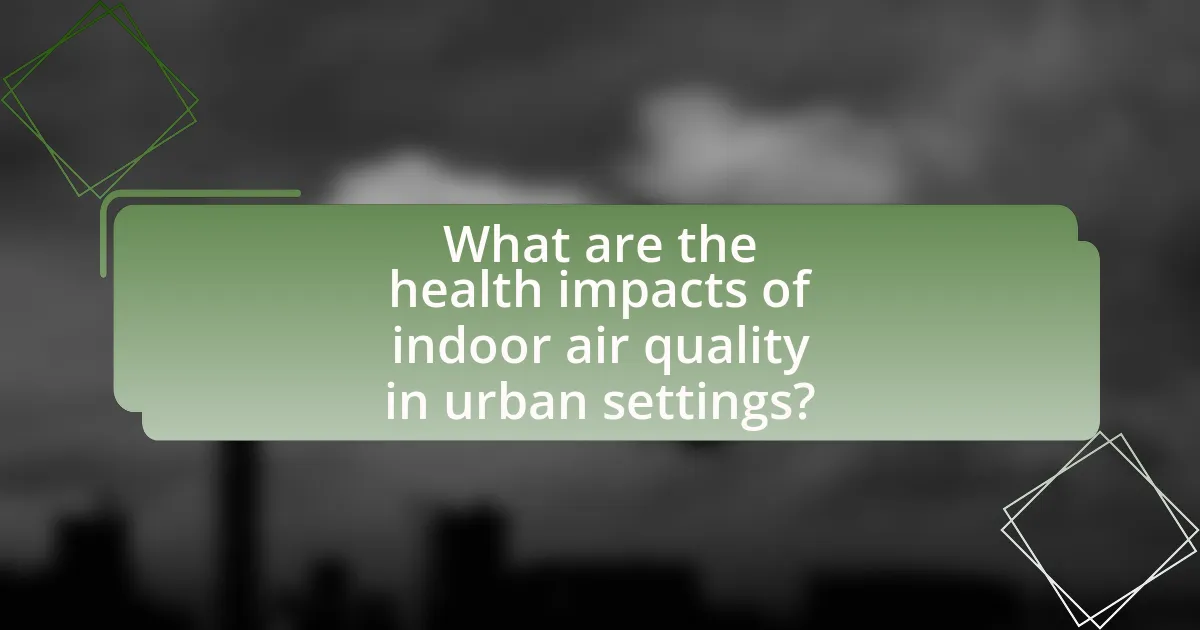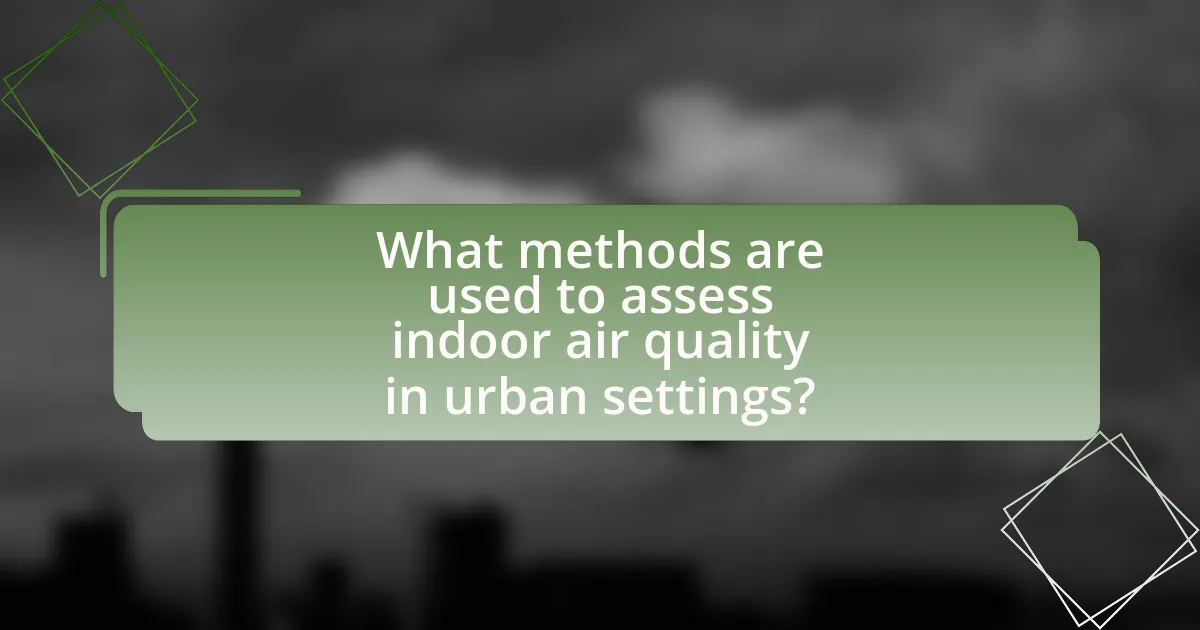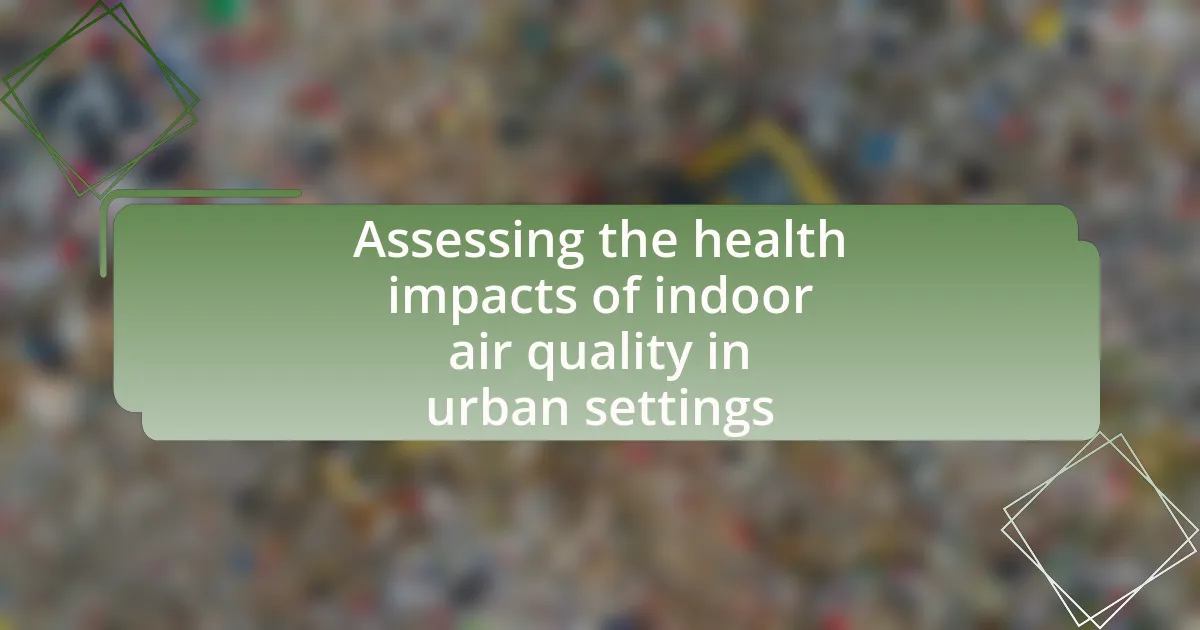The article focuses on the health impacts of indoor air quality in urban settings, highlighting how poor air quality contributes to respiratory issues, cardiovascular diseases, and mental health problems. It examines specific pollutants such as particulate matter, volatile organic compounds, and nitrogen dioxide, detailing their sources and effects on health, particularly among vulnerable populations like children and the elderly. The article also discusses the importance of assessing indoor air quality, the challenges faced in urban environments, and strategies for improvement, including urban planning and community engagement. Additionally, it outlines methods for measuring air quality and the role of public awareness in fostering healthier indoor environments.
What are the health impacts of indoor air quality in urban settings?

Indoor air quality in urban settings significantly impacts health, leading to respiratory issues, cardiovascular diseases, and exacerbated allergies. Poor indoor air quality often results from pollutants such as volatile organic compounds, particulate matter, and biological contaminants, which are prevalent in densely populated areas. Research indicates that exposure to these pollutants can increase the risk of asthma and other chronic respiratory conditions, with studies showing that individuals living in urban environments are more likely to experience these health problems compared to those in rural areas. For instance, a study published in the Journal of Environmental Health found that poor indoor air quality is linked to a 30% increase in asthma prevalence among urban children.
How does indoor air quality affect respiratory health?
Indoor air quality significantly affects respiratory health by influencing the prevalence of respiratory diseases and symptoms. Poor indoor air quality, characterized by high levels of pollutants such as particulate matter, volatile organic compounds, and biological contaminants, can lead to conditions like asthma, chronic obstructive pulmonary disease (COPD), and respiratory infections. Studies indicate that individuals exposed to indoor air pollutants are at a higher risk of developing these health issues; for instance, the World Health Organization reports that indoor air pollution is responsible for approximately 3.8 million premature deaths annually, primarily due to respiratory diseases. Furthermore, research published in the journal “Environmental Health Perspectives” highlights that children and the elderly are particularly vulnerable to the adverse effects of indoor air quality, experiencing increased rates of respiratory symptoms and hospitalizations.
What specific pollutants are most harmful to respiratory health?
The specific pollutants most harmful to respiratory health include particulate matter (PM2.5 and PM10), nitrogen dioxide (NO2), sulfur dioxide (SO2), ozone (O3), and volatile organic compounds (VOCs). Particulate matter, particularly PM2.5, can penetrate deep into the lungs and enter the bloodstream, leading to respiratory diseases and cardiovascular issues. Nitrogen dioxide, commonly produced from vehicle emissions, can irritate airways and exacerbate asthma. Sulfur dioxide, often released from industrial processes, can cause respiratory problems and aggravate existing lung diseases. Ozone at ground level can lead to decreased lung function and increased respiratory symptoms. Volatile organic compounds, found in many household products, can contribute to indoor air pollution and respiratory irritation. Studies have shown that exposure to these pollutants is linked to increased hospital admissions for respiratory conditions, highlighting their significant impact on respiratory health.
How do these pollutants vary in urban environments?
Pollutants in urban environments vary significantly due to factors such as traffic density, industrial activities, and building materials. For instance, nitrogen dioxide levels are typically higher near busy roadways, while particulate matter concentrations can increase in areas with heavy construction or industrial emissions. Studies have shown that urban areas often experience elevated levels of volatile organic compounds (VOCs) from sources like paints and cleaning products, which can contribute to indoor air quality issues. Additionally, temperature inversions in cities can trap pollutants close to the ground, exacerbating exposure risks for residents.
What are the mental health implications of poor indoor air quality?
Poor indoor air quality can lead to significant mental health implications, including increased anxiety, depression, and cognitive impairments. Research indicates that exposure to pollutants such as volatile organic compounds (VOCs) and particulate matter can negatively affect mood and cognitive function. A study published in the journal Environmental Health Perspectives found that individuals living in environments with high levels of indoor air pollution reported higher instances of psychological distress. Additionally, the World Health Organization has linked poor indoor air quality to a range of mental health issues, emphasizing the importance of maintaining clean air in urban settings to support overall mental well-being.
How does indoor air quality influence cognitive function?
Indoor air quality significantly influences cognitive function by affecting attention, memory, and decision-making abilities. Research indicates that exposure to pollutants such as volatile organic compounds (VOCs), particulate matter, and carbon dioxide can lead to decreased cognitive performance. For instance, a study published in the journal Environmental Health Perspectives found that higher levels of indoor air pollutants were associated with lower cognitive scores in tasks requiring complex thinking and problem-solving. This demonstrates a clear link between poor indoor air quality and impaired cognitive function, highlighting the importance of maintaining healthy indoor environments for optimal mental performance.
What is the relationship between indoor air quality and anxiety or depression?
Indoor air quality significantly impacts anxiety and depression levels. Poor indoor air quality, characterized by high levels of pollutants such as volatile organic compounds, particulate matter, and mold, has been linked to increased symptoms of anxiety and depression in various studies. For instance, research published in the journal Environmental Health Perspectives found that individuals exposed to higher levels of indoor air pollutants reported greater psychological distress and depressive symptoms. This relationship is attributed to the physiological effects of air pollutants on the brain, including inflammation and oxidative stress, which can exacerbate mental health issues.
Why is it important to assess indoor air quality in urban settings?
Assessing indoor air quality in urban settings is crucial for protecting public health and ensuring environmental safety. Urban areas often have higher concentrations of pollutants due to traffic, industrial activities, and dense populations, which can lead to respiratory issues, cardiovascular diseases, and other health problems. Studies indicate that poor indoor air quality can exacerbate conditions such as asthma, with the World Health Organization estimating that indoor air pollution contributes to approximately 4.3 million premature deaths annually. Therefore, regular assessment of indoor air quality helps identify harmful pollutants and implement necessary interventions to improve health outcomes in urban populations.
What are the unique challenges of urban indoor air quality assessment?
Urban indoor air quality assessment faces unique challenges primarily due to the complexity of pollutant sources and variability in building characteristics. The presence of diverse indoor pollutants, such as volatile organic compounds, particulate matter, and biological contaminants, complicates the identification and quantification of air quality issues. Additionally, urban environments often feature a mix of residential, commercial, and industrial spaces, leading to fluctuating exposure levels based on location and time.
Furthermore, the influence of outdoor air quality, which can significantly affect indoor conditions, adds another layer of complexity. For instance, studies have shown that outdoor pollution can infiltrate buildings, impacting indoor air quality and health outcomes. The variability in ventilation practices and building materials across urban settings also contributes to inconsistent air quality measurements. These factors highlight the need for tailored assessment strategies that consider the specific characteristics of urban indoor environments to accurately evaluate health impacts.
How can urban planning improve indoor air quality?
Urban planning can improve indoor air quality by integrating green spaces, optimizing building designs, and implementing strict zoning regulations. Green spaces, such as parks and urban forests, enhance air filtration and reduce pollutants, as demonstrated by a study from the University of California, which found that urban greenery can lower particulate matter levels by up to 30%. Optimized building designs that promote natural ventilation and use non-toxic materials can significantly reduce indoor air contaminants. Additionally, zoning regulations that separate industrial areas from residential zones can minimize exposure to harmful emissions, as evidenced by research from the Environmental Protection Agency, which highlights the correlation between zoning practices and reduced respiratory issues in urban populations.
What methods are used to assess indoor air quality in urban settings?

Methods used to assess indoor air quality in urban settings include direct measurement of pollutants, surveys of occupant health and comfort, and the use of air quality indices. Direct measurement involves using instruments to quantify levels of specific contaminants such as particulate matter, volatile organic compounds, and carbon dioxide. Surveys collect data on occupants’ perceptions of air quality and health symptoms, providing qualitative insights. Air quality indices aggregate various pollutant levels into a single score, facilitating easier interpretation of air quality status. These methods are validated by studies showing correlations between measured pollutants and health outcomes, emphasizing their effectiveness in assessing indoor air quality.
How are indoor air quality measurements conducted?
Indoor air quality measurements are conducted using a combination of direct sampling and monitoring techniques. These methods typically involve the use of specialized instruments that detect and quantify pollutants such as particulate matter, volatile organic compounds, carbon dioxide, and other harmful substances present in the air. For instance, real-time monitoring devices can continuously assess air quality parameters, while grab sampling techniques can collect air samples for laboratory analysis. Studies have shown that accurate indoor air quality assessments are crucial for understanding health impacts, as poor air quality is linked to respiratory issues and other health problems.
What tools and technologies are commonly used for measurement?
Commonly used tools and technologies for measurement in assessing indoor air quality include air quality monitors, gas analyzers, and particulate matter sensors. Air quality monitors provide real-time data on pollutants such as carbon dioxide, volatile organic compounds, and particulate matter, which are critical for evaluating health impacts. Gas analyzers specifically measure concentrations of harmful gases like carbon monoxide and nitrogen dioxide, while particulate matter sensors quantify the levels of fine and coarse particles in the air. These technologies are essential for understanding the relationship between indoor air quality and health outcomes in urban environments.
How do sampling methods differ in various urban environments?
Sampling methods differ in various urban environments primarily due to the unique characteristics and challenges presented by each setting. For instance, densely populated areas may require stratified sampling to ensure representation across different demographics, while less populated regions might utilize simple random sampling. Additionally, environmental factors such as pollution sources, building types, and ventilation systems influence the choice of sampling techniques, necessitating tailored approaches like passive sampling in areas with low air movement or active sampling in high-traffic zones. Research indicates that these adaptations are crucial for accurately assessing indoor air quality and its health impacts, as highlighted in studies examining urban air pollution and its correlation with respiratory diseases.
What standards and guidelines exist for assessing indoor air quality?
Standards and guidelines for assessing indoor air quality include the World Health Organization (WHO) guidelines for indoor air quality, which provide recommendations on acceptable levels of various pollutants. The United States Environmental Protection Agency (EPA) also offers guidelines that focus on specific indoor air pollutants, such as radon, carbon monoxide, and volatile organic compounds (VOCs). Additionally, the American Society of Heating, Refrigerating and Air-Conditioning Engineers (ASHRAE) has standards that address ventilation and indoor air quality, specifically ASHRAE Standard 62.1, which outlines minimum ventilation rates. These standards are based on extensive research and aim to protect public health by ensuring safe indoor environments.
Which organizations set these standards?
The organizations that set standards for indoor air quality include the World Health Organization (WHO), the Environmental Protection Agency (EPA), and the American Society of Heating, Refrigerating and Air-Conditioning Engineers (ASHRAE). WHO provides guidelines on indoor air quality to protect public health, while the EPA establishes regulatory standards and conducts research on air pollutants. ASHRAE develops standards for ventilation and indoor air quality to ensure safe and healthy environments. These organizations are recognized for their authoritative roles in establishing and promoting standards related to indoor air quality.
How do these standards impact public health policies?
Standards for indoor air quality significantly influence public health policies by establishing benchmarks for acceptable air quality levels, which guide regulatory frameworks and health interventions. These standards inform policymakers on the necessary measures to mitigate health risks associated with poor air quality, such as respiratory diseases and cardiovascular issues. For instance, the World Health Organization’s air quality guidelines provide evidence-based recommendations that countries can adopt to improve public health outcomes. By adhering to these standards, public health policies can effectively target pollution sources, promote cleaner air initiatives, and ultimately enhance community health and well-being.
What role do community assessments play in understanding indoor air quality?
Community assessments play a crucial role in understanding indoor air quality by identifying specific pollutants and sources within a given environment. These assessments involve systematic data collection and analysis, which help to pinpoint areas with poor air quality and the demographic groups most affected. For instance, studies have shown that community assessments can reveal high levels of particulate matter and volatile organic compounds in urban settings, leading to targeted interventions. By engaging local residents and stakeholders, these assessments also foster awareness and promote community-driven solutions to improve indoor air conditions, ultimately contributing to better public health outcomes.
How can community engagement improve assessment outcomes?
Community engagement can improve assessment outcomes by fostering collaboration between researchers and local residents, leading to more accurate data collection and relevant insights. Engaged communities provide firsthand knowledge about their environments, which enhances the understanding of indoor air quality issues specific to urban settings. Studies have shown that participatory approaches, such as community-based participatory research, result in higher response rates and more comprehensive data, ultimately leading to better-informed health interventions. For instance, a study published in the Journal of Environmental Health highlighted that involving community members in the assessment process increased the identification of pollution sources and health concerns, thereby improving the overall effectiveness of the assessment outcomes.
What are the benefits of participatory research in urban settings?
Participatory research in urban settings enhances community engagement and ensures that the research addresses the actual needs and concerns of residents. This approach fosters collaboration between researchers and community members, leading to more relevant and actionable findings. For instance, studies have shown that involving local populations in the research process can improve data accuracy and increase the likelihood of implementing effective interventions. Additionally, participatory research empowers communities by giving them a voice in the research that affects their lives, which can lead to greater trust and cooperation between researchers and participants.
What strategies can be implemented to improve indoor air quality in urban settings?

To improve indoor air quality in urban settings, strategies such as enhancing ventilation, using air purifiers, and implementing green building practices can be effectively employed. Enhanced ventilation increases the exchange of indoor and outdoor air, reducing pollutants; studies show that proper ventilation can lower indoor particulate matter levels by up to 50%. Air purifiers equipped with HEPA filters can capture airborne contaminants, significantly improving air quality, as evidenced by research indicating a 30% reduction in allergens and pollutants in treated spaces. Additionally, green building practices, including the use of low-VOC materials and incorporating plants, contribute to healthier indoor environments, with studies demonstrating that biophilic design can improve air quality and occupant well-being.
How can building design contribute to better indoor air quality?
Building design can significantly enhance indoor air quality by incorporating effective ventilation systems, using low-emission materials, and optimizing natural light. Effective ventilation systems, such as mechanical ventilation with heat recovery, ensure a continuous supply of fresh air while reducing energy costs. The use of low-emission materials, including paints, adhesives, and flooring, minimizes the release of volatile organic compounds (VOCs) that can degrade air quality. Additionally, maximizing natural light through strategic window placement can reduce reliance on artificial lighting, which often contributes to indoor pollutants. Research indicates that improved ventilation can lower indoor pollutant levels by up to 50%, demonstrating the critical role of building design in promoting healthier indoor environments.
What are the key design features that enhance air quality?
Key design features that enhance air quality include effective ventilation systems, the use of low-emission materials, and the incorporation of air purification technologies. Effective ventilation systems, such as mechanical ventilation with heat recovery, ensure a continuous supply of fresh air while reducing energy consumption. Low-emission materials, including paints, adhesives, and furnishings, minimize the release of volatile organic compounds (VOCs) that can degrade indoor air quality. Air purification technologies, such as HEPA filters and UV-C light systems, actively remove pollutants and pathogens from the air, contributing to a healthier indoor environment. These features collectively improve air quality, which is crucial for reducing health risks associated with poor indoor air conditions, particularly in urban settings where pollution levels are often higher.
How does ventilation play a role in indoor air quality improvement?
Ventilation significantly improves indoor air quality by facilitating the exchange of indoor air with outdoor air, thereby reducing the concentration of indoor pollutants. Effective ventilation systems can lower levels of volatile organic compounds, carbon dioxide, and other harmful substances, which are commonly found in urban indoor environments. Studies indicate that proper ventilation can lead to a 30% reduction in indoor air pollutants, enhancing overall health and comfort for occupants.
What are effective policies for managing indoor air quality in urban areas?
Effective policies for managing indoor air quality in urban areas include implementing strict building codes, promoting the use of low-emission materials, and enhancing ventilation standards. These policies are crucial as they directly influence the levels of pollutants such as volatile organic compounds (VOCs) and particulate matter, which can adversely affect health. For instance, research indicates that improved ventilation can reduce indoor air pollutants by up to 50%, significantly lowering the risk of respiratory diseases and other health issues associated with poor air quality. Additionally, public awareness campaigns can educate residents about the importance of maintaining good indoor air quality, further supporting these policies.
How can regulations be enforced to ensure compliance?
Regulations can be enforced to ensure compliance through a combination of monitoring, penalties, and public awareness initiatives. Effective enforcement mechanisms include regular inspections and assessments of indoor air quality in urban settings, which can identify non-compliance with established standards. For instance, the Environmental Protection Agency (EPA) conducts inspections and can impose fines for violations of air quality regulations, thereby incentivizing adherence. Additionally, public awareness campaigns can educate stakeholders about the importance of compliance, fostering a culture of accountability. Studies have shown that regions with stringent enforcement and public engagement see improved air quality outcomes, demonstrating the effectiveness of these strategies.
What role do public awareness campaigns play in improving air quality?
Public awareness campaigns play a crucial role in improving air quality by educating the public about pollution sources and promoting behavioral changes. These campaigns raise awareness about the health impacts of poor air quality, encouraging individuals and communities to adopt practices that reduce emissions, such as using public transportation, reducing energy consumption, and supporting clean air policies. For instance, studies have shown that cities implementing public awareness initiatives have seen significant reductions in air pollution levels; for example, the “Breathe Easy” campaign in Los Angeles led to a 10% decrease in particulate matter over five years. This evidence demonstrates that informed communities are more likely to engage in actions that contribute to better air quality.
What practical tips can individuals follow to enhance indoor air quality?
To enhance indoor air quality, individuals can implement several practical tips. Regularly ventilating living spaces by opening windows or using exhaust fans helps reduce indoor pollutants and brings in fresh air. Maintaining optimal humidity levels between 30% and 50% prevents mold growth and dust mites, which thrive in damp conditions. Using air purifiers with HEPA filters effectively captures airborne particles, including allergens and pollutants. Additionally, minimizing the use of synthetic fragrances and harsh cleaning products reduces the introduction of volatile organic compounds (VOCs) into the air. Regularly cleaning and replacing HVAC filters ensures efficient air circulation and filtration. These practices are supported by studies indicating that improved ventilation and air filtration significantly enhance indoor air quality and reduce health risks associated with poor air quality.
How can regular maintenance of HVAC systems improve air quality?
Regular maintenance of HVAC systems significantly improves air quality by ensuring that filters are clean and functioning properly, which reduces the circulation of dust, allergens, and pollutants. When HVAC systems are regularly serviced, components such as filters, ducts, and coils are cleaned or replaced, preventing the buildup of contaminants that can degrade indoor air quality. According to the Environmental Protection Agency, proper maintenance can reduce airborne particles by up to 50%, leading to healthier indoor environments.
What are some simple lifestyle changes that can reduce indoor pollutants?
To reduce indoor pollutants, individuals can implement several simple lifestyle changes. Regularly ventilating living spaces by opening windows or using exhaust fans can significantly decrease indoor air contaminants. Additionally, using air purifiers equipped with HEPA filters can effectively capture particulate matter and allergens. Reducing the use of synthetic fragrances and opting for natural cleaning products can also minimize chemical exposure. Furthermore, maintaining low indoor humidity levels through dehumidifiers can prevent mold growth, a common indoor pollutant. These changes are supported by research indicating that improved ventilation and air purification can lead to better indoor air quality and reduced health risks associated with pollutants.

Leave a Reply